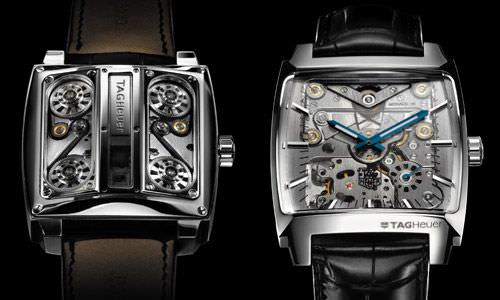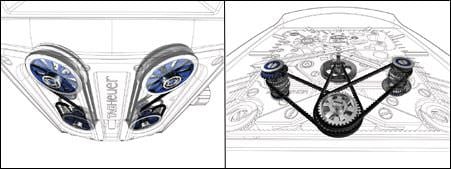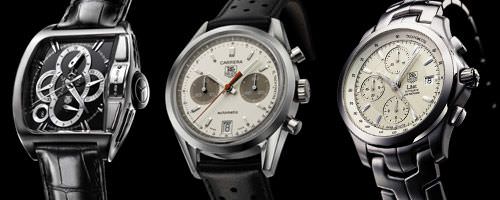
At the end of their first discussion, Philippe Dufour said that as much as the idea was interesting, it was decidedly too crazy to actually be realized. But Jean-François Ruchonnet (a young and successful entrepreneur, trained in micromechanics, who had notably designed some of the most beautiful synthetic images) is steadfast. Far from abandoning his idea, he refined and improved it, then returned to see Philippe Dufour.
Dufour, considered by his peers to be one of watchmaking’s most talented members, looked again at the drawings, scratched his head, thought about it, and had to admit that Ruchonnet was right to persist with his ‘crazy’ idea. His movement not only had a good chance of working, but it could very well revolutionize the world of the mechanical calibre.

The end of the gear train
In traditional watchmaking, there is an age-old principle: power and motion are transmitted by gears. Whether circular gears, bevel gears, helical gears, worm gears, lantern gears or differential gears, the gear form the basis of mechanical timemaking.
But now, enter Ruchonnet. His idea was to replace the gears by notched drive belts, just like in a car engine. So, what were the potential advantages of this world first ‘revolution’ in wristwatch movementsı In a traditional calibre, if we want to transmit power and motion from one point to another, we need to add more gears. On the other hand, with a drive belt system, we can go basically anywhere we want, with no obstacles.
The second advantage is that a drive belt absorbs shocks more easily because of its flexibility. But Ruchonnet didn’t stop there. He also wanted to eliminate the need for lubrication, which would therefore cut down on the indispensable maintenance required for the smooth operation of a watch. Thus, he proposed replacing the traditional jewels (the red synthetic rubies) by ceramic micro ball-races, the smallest of which is 2.2 mm in diameter and 0.5 mm high, which would dramatically reduce the effects of friction.
The third ‘revolution’ involved the oscillating mass, or weight, which traditionally is superimposed on the movement and moves in a rotational manner. Ruchonnet came up with the idea of having a linear oscillating weight made up of a 4.25-gram platinum ingot that moves up and down on a track between the four spring barrels. A gear system on the long side of the weight engages a cogwheel and converts the linear motion into a rotating movement.
A shared folly
“What is great about this project,” explains Philippe Dufour, “is that people finally began to understand Ruchonnet’s folly. It took a lot of courage to take on such a venture.”
And courage is what TAG Heuer and its CEO Jean-Christophe Babin have definitely demonstrated. Excited by the idea of “defying the most established conventions,” comforted by the strong tradition of innovation that is at the core of the brand’s identity, Babin placed all of the resources of his enterprise, both human and technological, in the service of this new concept. Eighteen months of development were needed to bring the Monaco V4 Concept Watch to the prototype stage “just a few days before the BaselWorld fair.”
The bombshell
On the opening day of BaselWorld, TAG’s announcement of its new timepiece exploded like a bombshell in the terrain of mechanical watchmaking. As always, the analysts quickly became divided into two camps; they were either enthusiastic supporters or total sceptics. To the latter, who declared that beyond the functional prototype presented at BaselWorld, the Monaco V4 could never be made on a commercial scale, Philippe Dufour disagrees. “The idea is ingenius,” he declares, which certainly means something coming from the talented Master watchmaker who turned Ruchonnet’s idea into reality.
As for Jean-Christophe Babin, who makes no attempt to hide the difficulties that might arise before the watch can be manufactured on a commercial scale, his determination is absolutely unwavering. “It will take the time that it takes, but the Monaco V4 will be made on a commercial scale,” he insists.
Industrial solutions
Nothing is really preventing the commercialization of this remarkable watch because all the industrial solutions have already been found, especially in terms of the material necessary to make the 13 notched drive belts, whose tension is controlled by turnbuckles. The name V4 comes from the movement's four spring barrels, which are mounted on a V-shaped main plate and are visible on the reverse side of the watch.
It is impossible to know the exact nature of the material that makes up the drive belts. It is a special alloy with amazing properties, classed as a ‘defence secret’ by the French army. Just one of these micro drive belts, measuring only 0.5 mm by 0.45 mm, can support a weight of more than 40 kilos!
As for the famous spring barrels, each of the four can store 375 g of energy for a total strength of 1.5 kg. If one, two or even three of the barrels should stop working, the watch would still continue to tick away. The barrels are mounted in a V, at an angle of 15° in relation to the dial, reminiscent of a V-shaped car engine. Two constant velocity joints, also as in the world of the automobile, transmit their energy to the movement. They are supported by sapphire bridges, which have the added advantage of allowing the movement to be visible from below.
Total design
The Monaco V4 is also a success from a design standpoint for the simple reason that there is nothing ‘decorative’ about it, but rather it is all ‘design’. In other words, the form of the watch, emphasized by the bridges and the sapphire crystal, comes integrally from the functionality of the piece. The Monaco V4 does not have a ‘dial’ in the traditional sense of the term, but neither can it be classed as a ‘skeleton’ watch. Housed in the evolution of the brand’s famous TAG Heuer Monaco timepiece, created in 1964, the movement itself becomes the aesthetic expression of the watch.
As yet unknown potential
When we asked Philippe Dufour about the potential of this radical new approach to mechanical watchmaking, which is protected by 21 patents, his answer is surprising. “This approach was possible because Jean-François Ruchonnet is not a watchmaker, and therefore is free from the constraints of traditional thinking. What he conceived has simply opened a new door. Where will this new opening lead toı It is much too early to tell, or even to imagine for now. But, I am sure that the future development of this concept will permit us to come up with new functions or uses that we have not even thought of, since we don’t yet have the means to realize them. Just on the subject of the barrels alone, however, the considerable combined power of 1.5 kilos is enough to start us all dreaming…”
Post-Breguet watchmaking
The Monaco V4 is, in its own way, the first timepiece of a new era of 21st Century watchmaking. It marks the first step in a post-Breguet or post-Huygens type of timekeeping. For the first time in a wristwatch, there are drive belts, constant velocity joints, linear weights, and ball bearings, even though a traditional palette balance regulates the movement of the hour, minute and second hands.
The door has certainly been opened, and now we must go through to the other side. And, we must wait until 2005 or 2006 to slip a Monaco V4 Concept Watch on our wrist.
The creative and commercial dynamism of TAG Heuer is not only demonstrated by the Monaco V4. The brand has many other original technical credits to its name, such as the SLR Chronograph by TAG Heuer and the Mercedes-Benz SLR McLaren, as well as the limited edition of 1,964 pieces to commemorate the 40 years of its Monaco timekeeper, created in 1964 by Jack Heuer, and the Chronograph New Link, an automatic piece with a fixed bezel, designed by TAG Heuer in collaboration with Tiger Woods.

The SLR Chronograph TAG Heuer/ Mercedes-Benz SLR McLaren is the fruit of an unusual partnership. This watch will be reserved for buyers of the new and remarkable sports car, the Mercedes-Benz SLR McLaren. The car and the watch will bear the same number. From a design point of view, this watch is at the crossroads of classic watchmaking and technical innovation. Its traditionally looking dial has been revisited to give the chronographic functions a look more like the gauges in a sports car. The hour is at 12 o’clock, seconds are at 9 o’clock, and minutes are indicated by a centre hand. The chronograph hour counter is at 6 o’clock, with the 30-minute counter at 3 o’clock, and a central seconds hand. The tonneau shape combined with the decorated middle case with its stylized grill design evokes the lateral air vents of the car.
From a technical point of view, this watch is equipped with a Calibre 36 Regulator, an automatic chronograph movement to one-tenth of a second, and it incorporates a size innovation (a new concept by Jean-François Ruchonnet). The chronograph pushbuttons are on the top of the case rather than in the side. Ergonometric, this innovative design calls to mind the gear shift on the steering wheel of the SLR and is a first in watchmaking.
The TAG Heuer / Tiger Woods New Link automatic chrono with fixed bezel
The world champion in golf for five consecutive years, Tiger Woods, an ‘ambassador’ of the brand, has been directly involved with TAG Heuer in the design of a new model for the New Link collection. An automatic chronograph with a fixed bezel, featuring pure lines that are both sophisticated and minimalist, the New Link is emblematic of sport and elegance. It comes with a satin-finished stainless steel bracelet in the form of an S, combining fluidity, comfort and an ergonometric form, with a fold-over buckle affording double security to avoid accidental opening. Other features include a case measuring 41.9 mm in diameter, a scratch-resistant sapphire crystal, screw-in crown with double closing, and water resistance to 200 metres. Three models are being proposed: a black dial with fixed bezel in satin-finished stainless steel; a silver dial with a polished steel fixed bezel; a blue dial with a polished steel fixed bezel. The golfers of the world can now wear a watch truly made for them.
The 40 years of the Carrera
In 1964, Jack Heuer introduced the Carrera, a chronograph whose design was already inspired by the automobile and which marked its epoch by its innovation, its clear styling and the readability of its display. Re-issued in 1966 using the dimensions of that period (37mm) and a man-ual winding movement, TAG Heuer adapted it, in collaboration with Jack Heuer, and launched a 39 mm model in 2002. It is equipped with an automatic winding movement, and was followed in 2003 by the Carrera Watch Gold, Twin Time, and Nacre.
This year, to celebrate the 40th anniversary of its mythic model, TAG Heuer is presenting a limited series of 1,964 pieces with a unique design. Its dial includes two anthracite counters, a tachometer at 3 o’clock, a red seconds hand, and a date window at 6 o’clock. The Carrera 1964 is equipped with a mechanical movement based on the ETA 2894 calibre and bears the signature of Jack Heuer engraved on its steel screw-in case back, with the mention "40 years of legend” and the individual number of the piece.






